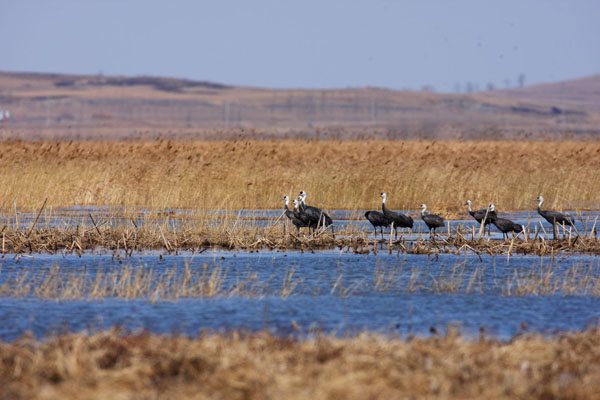Grus monacha
IUCN
LCBasic Information
Scientific classification
- name:Grus monacha
- Scientific Name:Grus monacha,Hooded Crane,Pot Crane, Black Crane, Nun Crane
- Outline:Wading birds
- Family:Gruiformes Gruiformes Grus
Vital signs
- length:92-97cm
- Weight:3284-4870g
- lifetime:50years
Feature
The white "head" is very conspicuous, and most of the body is gray-black, making it easy to identify.
Distribution and Habitat
In China, they breed in the forest swamps of Xiaoxing'anling in Heilongjiang, and hibernate in wetlands such as lakes and rivers in the middle and lower reaches of the Yangtze River. Abroad, they breed in northern Siberia and hibernate in the Korean Peninsula and southern Japan.
In summer, they live in swamps near lakes and rivers, preferring habitats with trees, and move in pairs or family groups. During migration and hibernation, they move in large groups, live in inland or estuarine wetlands, and often enter farmland to forage.
Appearance
Small in size, with a white head and neck, black front and end of the crown and red in the middle. The rest is uniform dark gray. Juveniles and sub-adults have yellowish heads and necks, black eye spots, yellow-red irises, greenish beaks, and nearly black feet.
Details
The white-headed crane is a large wading bird with a long neck, beak, and legs. It is gentle, alert, and timid. It has a white gray coat and a snow-white neck. It migrates in spring from late March to late April and arrives at its breeding grounds in late April and early May. It migrates in autumn from October 11 to November 7, and arrives at its wintering grounds in late November. It breeds in Inner Mongolia and the Ussuri River Basin in China and winters in the lower reaches of the Yangtze River.

Often move in pairs or family groups, sometimes alone or in loose groups composed of family groups, often digging for food in the mud while walking. In winter, they often move and forage in farmlands near their habitats. In the absence of interference, the places where they live and forage are relatively fixed. They are alert in temperament, often looking up and watching when they are active and foraging, and flap their wings to take off when there is danger, circling in the air, and chirping continuously. When flying, they often form a "human" or "one" shape.
White-headed cranes have good hygiene habits. They spend a lot of time combing their feathers every day to ensure that they are "dressed and well-groomed". When incubating eggs, they often repair and tidy up their love nests. They never defecate around the nest. Even if the incubating birds are in a hurry, they always go to the same fixed place - the tower head room about 5-8 meters downstream of the nest to defecate. Therefore, the nest of the white-headed crane has no odor and is very clean. The white-headed crane is very "gentlemanly" in the process of feeding and never overeats. No matter how much food there is, they always pick it up one by one and eat it bite by bite.
They mainly feed on crustaceans, small fish, mollusks, myriapods, and insects and larvae such as Orthoptera, Lepidoptera, snails, eels, and Odonata. They also eat tender leaves and tubers of plants such as mosses, Polygonum aviculare, and Potamogeton, as well as plant foods and crops such as wheat and rice. In the breeding grounds, the white-headed crane eats a lot of mountain cranberries, especially a plant called blueberry in the swamp. In summer, it also eats insects, frogs and salamanders, but the main food is still plant food. In the wintering grounds, it mainly eats grains such as rice, wheat, and barley, and also eats mollusks and insects.

The white-headed crane is a secretive member of the crane family. The white-headed crane reaches sexual maturity at the age of 4-5. Once a family is formed, the relationship between the husband and wife is very stable. Generally, the age of the husband and wife is slightly different, and the male is more than one year older than the female. They are almost inseparable all year round.
People have praised the white-headed crane as a "love bird" more than once, and even the wedding souvenirs given to friends are printed with: "With the crane as a matchmaker, grow old together."
The white-headed crane is a flagship species of wetlands and a national first-class protected wild animal. There are only 14,500-16,000 left in the world, and it is listed in China's national key protection level: first level, effective year: 1989.








